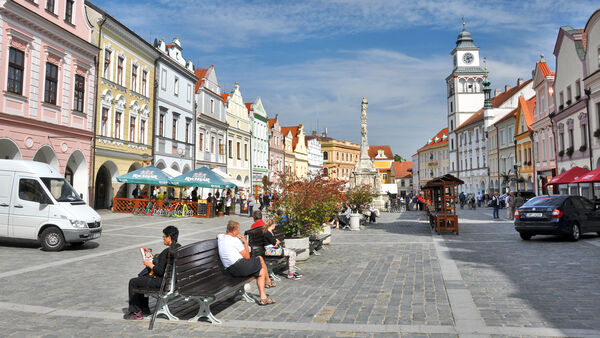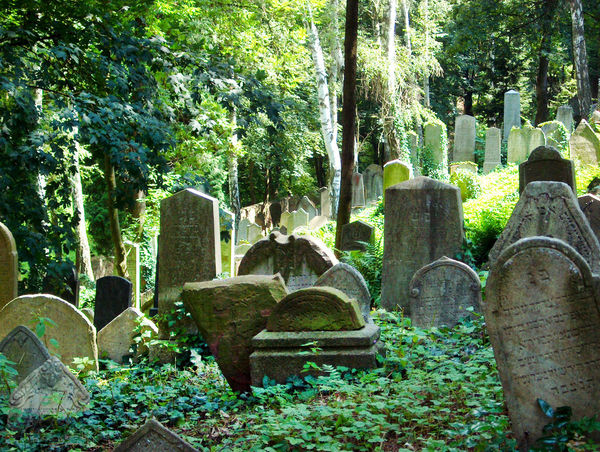Třeboň and Třebíč: Two Gems of the Czech Countryside
By Rick Steves

If you're traveling in the Czech Republic south of Prague, you may have the famously cute town of Český Krumlov on your itinerary. While it's delightful, two nearby towns — straddling the regions of Bohemia and Moravia — feel less commercial and, for many, equally worthwhile.
Třeboň, a well-preserved town with an inviting Renaissance square, is nestled in a bucolic landscape of rolling hills. Its claim to fame is its nearby biosphere of artificial lakes that date back to the 14th century. Over the years, people have transformed what was a flooding marshland into a clever combination of lakes, oak-lined dikes, wild meadows, Baroque villages, peat bogs, and pine woods. Rather than unprofitable wet fields, the nobles wanted ponds swarming with fish — and today Třeboň remains the fish-raising capital of the Czech Republic.
The city is all about fish — on the main square, the bank has a statue of a man holding a big fish over its door. Another statue honors the town's 16th-century megalomaniac lake-builder Jakub Krčín (now considered a hero, since his medieval lakes absorbed enough water to save Třeboň from a 2002 flood that ravaged Prague).
When you come here, you must eat fish. So I ordered every appetizer at a local eatery, tapas-style (a good trick when trying to eat your way through another culture): soused (marinated) herring, fried loach, "stuffed carp sailor fashion," cod liver, pike caviar, and something my Czech friend translated as "fried carp sperm."
As we ate, I noticed the writing on my beer glass: "Bohemia Regent anno 1379." It occurred to me that I was consuming exactly what people have been eating and drinking here for over 600 years: fish from the reservoir just outside the gate, and the local brew.
Třeboň is also renowned for its spa, where people come from near and far to bathe in peaty water. Soaking in the black, smelly sludge is thought to cure aching joints and spines. Envisioning the elegance of Germany's Baden-Baden, I had to give it a whirl. Besides, I thought it would make good TV.
My attendant didn't understand why I had an entourage (local guide/translator, producer, and cameraman). She just treated me like the village idiot she was assigned to bathe and massage. She pointed to my room and mimed to take off everything. But I kept my military-green swimsuit on (afraid of a prankish combination of high-definition footage, my producer's sense of humor, and YouTube).
Camera work is slow. She was anxious. The peat muck only flows at the top of the hour. I climbed into my stainless-steel tub, she pulled a plug, and I quickly disappeared under a rising sea of dark-brown peat broth (like a gurgling sawdust soup).
Then, my tub was full and all was silent. My toes looked cute poking out of the hot brown muck. She kept acting like I would overdose if I stayed in too long. But we filmed our bit — one of the craziest-looking sequences we've ever done.
After that humiliation, I was happy to escape to the nearby town of Třebíč: another Czech gem with a wonderful main square. Třebíč also has a compelling historic Jewish district. While Prague's Jewish Quarter is packed with tourists, in Třebíč you'll have an entire Jewish town to yourself.
Třebíč's Jewish settlement was always relatively small, and of the 35 Třebíč Jews who survived the Holocaust, only 10 returned home. What's left of the quarter is amazingly authentic. The houses have been essentially frozen in time for the better part of a century. Among the 100 or so preserved buildings are two synagogues, a town hall, a rabbi's house, a poorhouse, a school, and a hospital.
In the 1970s, the ghetto was slated for destruction; the Communists wanted to replace it with their architectural forte: an ugly high-rise housing complex. Thankfully, the land proved unable to support a huge building project and the neighborhood survived. Today, what locals claim is the largest preserved Jewish quarter in Europe is protected by the Czech government. Over the past couple of decades, the ghetto has gradually found its new identity, as artisans ranging from blacksmiths to chocolatiers moved their workshops here.
One of Třebíč's most moving sights is its cemetery. This memorial park is covered with spreading ivy, wild strawberry bushes, and a commotion of 4,000 gravestones (dating back to 1631). If you visit, note how the tombstones reflect the assimilation of the Jews, from simple markers to fancy 19th-century headstones that look exactly like those of the rich burghers in Christian cemeteries.
So much of Europe is crowded, industrialized, hamburgerized, and without a hint of the everything-in-its-place, fairy-tale land so many travelers seek. But traveling along Czech byways, you'll enjoy traditional towns and villages, like Třeboň and Třebíč, with great prices, a friendly and gentle countryside dotted by nettles and wild poppies — and fewer tourists.

